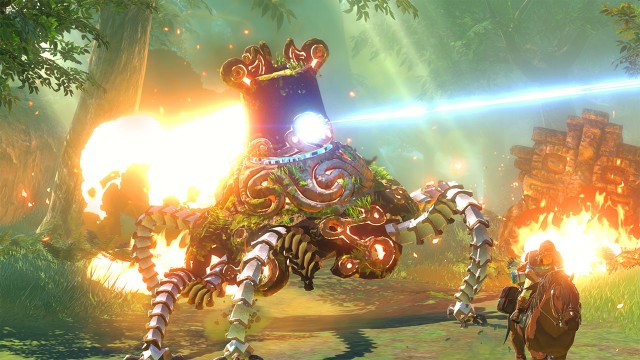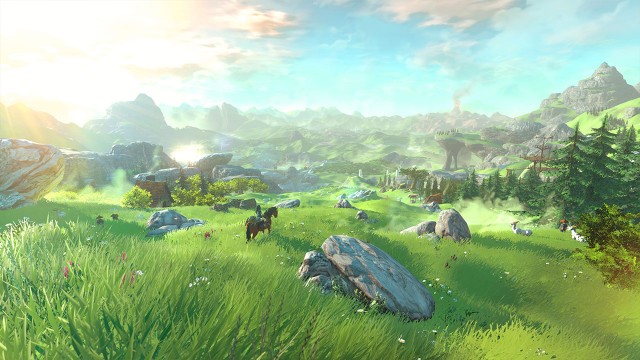The Legend of Zelda is one of the key franchises in Nintendo’s arsenal and one that has expanded exponentially since the release of its eponymous installment in 1987. While the look and feel of the original has been preserved in the top-down Zelda titles, the series has become better known for many gamers through its innovative 3D adventure games. Wii’s focus away from raw power saw a change in the series, though, with a greater emphasis on artistic style and console specific controls. But alongside this, The Legend of Zelda: Skyward Sword arguably lacked a lot of the innovative design that characterized the earlier games. This looks set to change in 2016 with the release of the unnamed Wii U installment, with all signs suggesting that this next entry in the series represents a radical shift forward for the franchise– an idea that is echoed in Nintendo’s own plans for 2016.
Of course, the Legend of Zelda series has always been incredibly varied in terms of style, gameplay, and tone. It goes without saying, however, that it is known for being consistently high in quality. Indeed, I don’t need to go into any great depth about this (Robert covers this and more about the entire series particularly well here), and it is just one aspect which gamers generally associate as being characteristic of the series as a whole. A wide scope, a freely traversable land, and stories that traverse time and space, for example, could apply to any number of Zelda games. The freedom to play dungeons in whatever order you wish in A Link Between Worlds, for instance, was a trend which only re-emerged after what had been a growing linearity in the series. Since the debut of the 3D console games on the N64, the series has increasingly been synonymous with large worlds, tight gameplay, and (historically) impressive graphics. In fact, the games as a whole have set trends that have continued to be followed across the industry, for example, with features such as Z-targeting.

Perhaps the most memorable feature of Skyward Sword, the last main entry in the series on consoles, was its Impressionist art style and its fantastic use of Wii Motion Plus for 1:1 actions. Swordplay became a puzzle in of itself as enemies blocked certain swipes, and, along with items like the Beetle, made the game a shining example of how motion gaming could be done right. But despite the accomplished motion controls and artistic flare, the game was lacking in certain other areas. My biggest criticism of the game at the time, for example, was the reuse of the three core areas (Faron Woods, Eldin Volcano, and Lanayru Desert) to the extent that while there was plenty of content, the scope of the game felt significantly reduced from what was seen in previous Zelda games.
Yet, despite being incredibly well received at the time, Nintendo seems to be well aware of the criticisms lobbied at Skyward Sword, and seems to be moving forward in a brave new direction for Zelda Wii U. A lot has changed in recent years and games like The Witcher 3 have shown that adventure games and RPGs can be open, massive in scope and full of intricate details that help it feel alive. Gone are the days when areas like Hyrule Field (incredible as it was at the time) can remain bare and unresponsive to the player’s actions. Should Nintendo try to copy very different games like The Witcher 3 in an attempt to appeal to gamers? Of course not– Nintendo has shown that it rarely copies what the competition is doing and that it often knows best when it comes to game design. Still, the limited details that Nintendo has shared about Zelda Wii U indicate that it knows that times have changed and it seems to be widening the scope and nature of the latest game in a way that we haven’t seen since the N64 entries (or perhaps Wind Waker).
In Zelda Wii U, we can expect to “explore a huge world on an unprecedented scale,” with Link facing “new puzzles and enemies in a vast Zelda world, without boundaries, that stretches off into the distance!” The scope of the game shown in early footage certainly seems vast, with waypoints and use of Epona necessary to traverse long distances. That the developers are also working on implementing small details in order to make the world feel more realistic– like how Epona won’t run into trees– seems only to reinforce this idea.

This is really the extent of what we know about the game though at this stage, and we have yet to see how successful Nintendo will be in creating a game with this level of ambition. Indeed, it’s been a while since Nintendo has really focussed on creating massive open worlds– we haven’t seen a Galaxy-esque HD Mario game, a Metroid Prime, or even a new HD Zelda release until Zelda Wii U. It is difficult and perhaps unrealistic then to expect Zelda Wii U to be as open, fully realized, or intricate as something like The Witcher 3, whose scope received such high praise at release.
But while it is all to easy to be pessimistic, Nintendo is no stranger to a challenge and seems to making a real effort to create a Zelda game that is on “an unprecedented scale.” In fact, there is a strong likelihood that the reason behind Zelda Wii U’s delay was partly a result of the developers working to ensure that the world is full to the brim with the details that people now expect in open world games. Nintendo is, after all, known for holding games back to ensure that the end result is as good as possible.

The Legend of Zelda series is known for making the most of the systems it appears on, from Z-Targeting, to the C-Stick, to motion controls, and I fully expect Zelda Wii U to do the same with its console this time around. But, the potentially more exciting aspect of this game could well be the attempts to expand on what we have come to expect from the Zelda series and make it a truly impressive and immersive AAA game for Wii U owners.
Certainly, the developers could play it safe with Zelda Wii U and people would still buy it in hordes. Instead, though, Nintendo seems to be working on making a truly revolutionary entry for the series, something which I for one am excited to hear more about in the coming months.




 ShareThis
ShareThis






